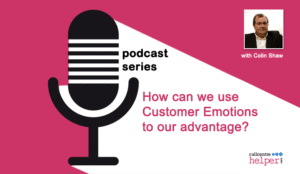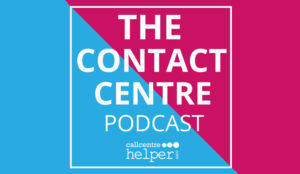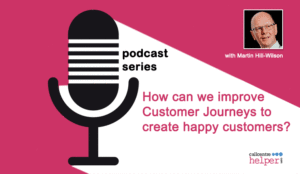
The Contact Centre Podcast: Episode One
In this episode, Colin Shaw of Beyond Philosophy discusses how we can evoke positive emotions from our customers, first focusing on the wider customer experience, before sharing some practical tips for contact centres.
As part of our discussion, we also talk about creating positive customer memories, increasing employee engagement and coaching contact centre advisors.
To listen to the podcast directly from this webpage, just hit the play button below:
The Contact Centre Podcast – Episode 1:
How Can We Use Customer Emotions To Our Advantage?
This podcast was made possible by our sponsor, Genesys.
Podcast Time Stamps
- 2:05 – Why does Customer Emotion Matter?
- 5:29 – Defining Customer Emotions
- 8:55 – The Impact of Customer Memories
- 15:24 – Don’t Forget About Employee Emotion!
- 18:23 – Targeting Trust as a Key Customer Emotion
- 25:00 – Testing Contact Centre Emotions
- 28:23 – Memory Maker Training
Here is a Transcript to the Podcast
Jonty Pearce: What do you think are the key components of designing an emotionally engaging customer experience?
Colin Shaw: Yeah, I think the issue for me is that most organizations still fail to recognize that customers are human beings. What we know is that over 50% of an experience is about how a customer feels. So by definition you should be looking at how you’re going to try to evoke emotions in customers. Now, let me also be clear. You’re evoking emotions in customers today. It’s just people aren’t in control of what emotions they’re evoking. And oftentimes they can be negative emotions. You’ve got to do things to design in a positive experience and use positive emotions.
Jonty: It’s a combination of eliminating the negative emotions and accentuating the positive.
Colin: Yeah. I think the first question I would ask anybody would be, “what emotion are you trying to evoke”? If you buy into the fact that your customers are human beings, if you buy into the fact that emotions drive human behaviour, then you should really be able to understand or you should have a clear picture of what the emotion is that you’re trying to evoke in your customers. And therefore, again, the second challenge I would put in there would be that the emotion that you’re trying to evoke in your customers has to be an emotion that drives and destroys value for you.
We did back in 2005 when we were talking about this stuff, a lot of our clients were rightly saying, “Well that’s really interesting. We buy into that. But prove to me that evoking emotions drives value.” We did two years’ worth of research with London Business School and it culminated in my third book, “The DNA of Customer Experience: How Emotions Drive Value”. And there we listed effectively 20 emotions that drive and destroy value for an organization.
Things like feeling frustrated, feeling annoyed, feeling hurried, feeling stressed, you can statistically prove will destroy value for you. You will lose. And when I say value, I’m talking about things like revenue, I’m talking about market share, retention, et cetera. And then there are emotions like trust or feeling cared for or feeling valued or feeling pleased or happy. And there are 12 emotions like that that are proven to drive value.
The first question is, what emotions are we trying to evoke? The second question is, well, we want to evoke emotions that drive value. Now once we’ve decided those things, now we design that experience to implement that, and therefore we now need to train people on how to evoke those emotions. In the call centre, how can we now train people to identify how a customer is feeling walking into the experience? And how can you convert them into feeling the emotion that they want to feel, you want them to feel, going out of the experience? Does that make sense?
Jonty: It does indeed. Your question was what emotion are you trying to evoke? What do customer service directors tell you is the emotion they’re trying to evoke? I hear a lot about customer delight, but that’s often just sort of a buzzword. What do people tell you is the emotion they want to evoke?
Colin: Well, so many different ones and therein lies part of the problem. Typically when you talk to somebody and you ask that question, they’ll go, “Well, we want customers to trust us, we want them to be reliable, we want them to feel valued.” But here’s the interesting bit.
I can go around an organization, and in fact I would ask that the listener does this: Next time they’re in a meeting, just stop and say to people, “Write down on a piece of paper what emotions we’re trying to evoke.” And get them to write it down individually. Then go round the table and ask people what they’ve written. And I guarantee it will be different.
Now some of those, things like trust, come out fairly regularly, but the issue is that the organization hasn’t strategically said this is what we’re trying to evoke in our customers. And therefore what each part of the organization does is they do what they think is the right thing and therefore customers feel different things. Sales do what they think is the right thing. Marketing do what they think is the right thing. Customer service, contact centres do what they think is the right thing and the customer feels something different because it has not been strategically decided.
Jonty: That’s quite interesting, the range and that disconnect. And I guess that forms almost part of the challenge with any organization: if you don’t know what you’re trying to achieve, it’s rather hard to achieve it.
Colin: Correct. Absolutely. The key issue for me is alignment or the lack of alignment. Without that clear articulation, everybody does what they think is the right thing. They have strategies for the rational things. We’ve launched this product and we want X amount of sales out of it, or we want to be known in the marketplace for innovation, or whatever it may be. And everybody sort of strives for that. Even internal values, here’s the internal values of our organization.
What they haven’t done is articulated the experience that they want customers to have. And that’s just a gap. And to be honest with you, that’s a gap that I noticed 20 years ago and it’s a gap that still exists, and that’s what we do with organizations to try to help them: (a) understand this stuff, but (b) then set the strategy to go, okay, what is the strategy? What is the experience you’re trying to deliver and the emotions you’re trying to evoke? And now how can you flow that down the organization? Because, and again, an area we haven’t spoke about yet, but it’s just measurement. How many organizations measure the experience, those emotions?
If you’re trying to get a customer to trust you or feel cared for, then guess what? You should be measuring that. And you should be measuring that at each of those interactions that you have. When people are phoning the contact centre, they should be asked those types of questions as well.
Jonty: On a recent podcast, you explained that if you’re trying to create an emotionally engaging customer experience. It’s really all about the memory of what people remembered about that experience, not necessarily the experience. Can you explain a bit more about that?
Colin: This is the biggest thing I’ve learned in the last 10 to 15 years, and I think that this is so fundamental that we don’t understand it. If you think about it – and I’m going to start from the top and then I’m going to work my way down – if you think about it, you want loyal customers, but loyalty is a function of memory. Loyalty means you’ve been there before, you’ve spoken to them before, and now you’re having… you’ve decided to go back. The only reason you’ve decided to go back is the memory that you had.
So the interesting question starts to become how are memories formed? And there’s a guy called professor Daniel Kahneman and Daniel Kahneman has won the Nobel prize for behavioural economics. And what Kahneman talks about is that what people remember in an experience is they remember the peak emotion that they felt and they remember the end emotion that they felt.
It’s called the peak-end rule. They remember the peak emotion, that can be positive or negative. And they remember the end emotion. And what Kahneman talks about is, and this, I think, is really profound: We don’t choose between experiences, we choose between the memory of an experience. If you think about that, we’re not choosing between the experience that we had. We are actually choosing between the memory.
Whoever’s listening to this podcast now or three days after you’ve listened to it, if you think back to this podcast, you will be thinking… by the very definition of the phrase thinking back means that you’re accessing your memory of what was said. And you won’t remember everything, but you will remember the key things and maybe hopefully we have evoked emotion, feeling intrigued or interested or whatever it may be.
The interesting part therefore becomes, it’s how a memory is formed and it comes back to emotions. Peak emotion, end emotion. That raises some really interesting questions. For example, what is the peak emotion that your customer is feeling today in that interaction with the contact centre? And where is the peak? Is it at the beginning? Is it halfway through the call? Is it at the end? And what is the end emotion that your customers are feeling today? And going back to our previous conversation, what do you want the customer to feel at the end of that experience? And how are you going to measure whether the customer is feeling those things? Because memories are the key to customer loyalty.
What Kahneman also talks about is the fact that endings are exceptionally important. Endings are actually more important than the peak. Again, how is the call being ended? Going back to what we just said about average call handling time, are you rushing customers off the call? What happens at the end of your call? Because that is absolutely critical to building that memory. And this comes under this whole area, Jonty, of what’s called behavioural economics. And it’s effectively how customers are behaving and the effects upon money.
Jonty: Indeed. And quite interesting. You’re talking about the peak effect. Now the peak effect, that could be a positive or a negative peak.
Colin: Correct, absolutely. It can be positive or negative and the end can be positive or negative as well. And therefore when people have an experience that’s negative… if I said to you, think about where you were on 9/11. Everyone can remember where they were at 9/11. Everyone can remember that terrible day. That is a memory that is stored in your brain with emotions attached to it. Think of a positive, think of a good vacation that you’ve had or the birth of one of your children or whatever it may be. Something happy that’s happened. Again, that’s a memory that’s stored in your brain and it’s got an attachment which is full of emotions.
The interesting bit is, and as I was thinking about this podcast today, the interesting bit – and I’m fascinated by this subject – is that memories can be altered. If you think about a memory, positive memory, negative memory. It’s like opening a Word document, making a change and saving it again. It’s slightly different.
If you start to think about vacations, holidays that you’ve had in the past and it’s become folklore within your family, something happened and everybody now laughs and jokes about it, it’s probably expanded in your memory 20 times to what actually happened and that’s because it gets re-examined, brought up, saved in a slightly different way. Re-examined, brought up, saved in a slightly different way and therefore it can change.
Part of the implications of this are if you’re asking your customers to constantly tell you about the problems that they’ve got, guess what happens to that memory? Do you think it gets better or do you think it gets worse? It clearly gets worse. You’re asking me to tell you again and now I’m feeling frustrated that I’m having to tell you again about the problem that I had. And then guess what? When I resave it, I’m resaving it with those new emotions attached to it. And therefore it starts to have some practical implications in the organization.
Jonty: Presumably there’s a link between how happy your employees are and how happy your customers are. And I know you wrote a book called “Happy Employees Make Happy Customers”. Is there any research that shows this is true?
Colin: Yeah, there’s loads of research. Back in the day there was a guy called Earl Sasser that wrote one of the first books that talked about the connection between employee satisfaction and customer satisfaction. But it’s a bit, again, if I just go to some practical things, let’s assume that we want to make our customers feel happy or we want our customers to feel excited and I now turn around to you and say, “You, Jonty, your job is to go and make customers feel happy. And if you don’t make them feel happy, then there’s going to be a real problem here.” In other words, it goes back to that word ‘alignment’, which is ideally, what you’re trying to do is if you’re trying to create an environment with your customers that’s around trust and feeling cared for and feeling valued, then guess what? The employee experience that you are trying to deliver should also be the same.
You should also be looking at evoking trust and cared for in your employees to make them feel happy because happy people are more likely, absolutely more likely, to provide a great customer experience than people that aren’t. And in fact, I’ll probably delete the word likely because creating that environment, a great employee experience, will absolutely create a great customer experience.
Jonty: And so does culture become then the big driver of that happy employee, happy customer approach?
Colin: Absolutely. It’s the classic line of culture eats strategy for breakfast. You can do all of the theory – and this is one of the reasons why we called our company Beyond Philosophy – you can do all the theory, you can have a great philosophy, you can put all of the intellect into creating your strategy, but if you don’t go beyond it and do something – hence our beyond philosophy – it goes nowhere. The culture of your organization is central to what you end up delivering.
If your organization is transactional, if you don’t trust your people, they’re not going to trust their customers. Imagine working in Ryanair where you’ve got O’Leary saying the types of things that he used to say about customers. Now does that give you licence to think and say those types of things about customers? Of course it does. You can have the best strategy in the world and the best theories in the world, but you’ve absolutely got to go beyond it and then actually start to do something.
Jonty: If you want to evoke, say, customer trust, you know you’ve got to change the culture to do that. What sort of practical steps can you do to develop, if you like, a trusting culture that leads to customers trusting you?
Colin: The first thing you’ve got to do is find out where the problem areas are today. Part of what we’re talking about here when we’re talking about culture is we’re talking customer-centricity and how customer-centric the organization is. Things like, if you just look at trust and empowerment, are the frontline empowered to make decisions? And invariably they’re not. Well, why is that? Well, actually, senior management don’t trust employees to make choices. And it’s the classic line of people that are in the contact centres are making big decisions every day on their mortgages and where they’re sending their kids to school and so on and so forth.
It’s about identifying those types of things. And it’s about in the case of trust, partly about creating that sense of empowerment. But it’s also about, again, if you… one of the things that annoys me intensely is if you look at an employee satisfaction survey, how many questions are in that survey about the customer? Do you think the organization is focused around the customer? Is my department committed to improving the customer experience, et cetera?
Colin: Again, most organizations don’t have that type of question, which shows that they are what we would call inside-out. In other words, they’re focused on themselves rather than what they should be, which is outside-in. Which is looking at what the customer wants and starting to change their organization. But the culture changes happen from the top. Just look at agendas for meetings. Where does reviewing the customer experience come? Is it not on the agenda? A monthly meeting, is it not on the agenda? Is it bottom of the agenda? Or is it atop of the agenda? Because that starts the game to give me an indication of how customer-centric and the culture of that organization. Because if it’s at the bottom, that’s great, but so at least you’ve got it there. But typically it gets done as the last thing. It’s the classic stuff of sort of like what gets measured gets done. Typically in most organizations, the first thing people talk about is revenue, which shows where their minds are.
Jonty: Indeed. It’s quite interesting you said about trusting your employees. My dear friend Paul Cooper wrote a great article for us called “It’s Not Empowerment Unless You Trust Your Employees”. And it’s not sufficient just to say, “Oh, you can give a £20 discount without asking a supervisor.” That’s just an authorization. That’s not a trust. Should you be putting specific trust questions in the employee survey?
Colin: Yeah. What you’re trying to do ideally is gain alignment. If you want your customers to feel trust, cared for and pleased, just picking three emotions, then guess what? Your employees should feel trust, cared for and pleased. And therefore how you – and again, this is stuff that we talk about in the new book – how you design your customer experience, it’s the same theory to design your employee experience. Why? Well guess what? Employees are human beings as well. And employees have emotions as well. And therefore designing your experience, understanding all of that again, behavioural science and why people do things and motivations applies to customers. And it also applies to employees.
If you’re trying to create an experience of trust, cared for and pleased with your customers, then the employee experience should be around trust, cared for and pleased as well. And therefore, what are you doing that’s stopping that? That’s a good example.
Jonty: Very good. The questions could be do you trust the company? Do you feel cared for in the company? What would be the question potentially for pleased?
Colin: Well it would just be something about are you pleased to be working in this organization? But I would also do it, I would do it further down than that. There’s one thing which is about the company, but then there is about the department and then there is about the frontline manager because, again, those can be different things. I would take it down to those as well.
Jonty: Oh, do you trust your manager? Do you feel cared for by your manager? That’s quite powerful.
Colin: Yeah. Yeah. Well, so you can trust the company, but I don’t trust my manager. I trust Apple, but I don’t necessarily trust what this bloke’s just told me in the Apple Store. I’ve got an overriding trust of Apple, but actually what this person’s just told me I think may be wrong. Ideally in the organization, if you’re doing an employee survey, it’s about the company, it’s about whichever division that you’re in and it’s about your individual manager. And you know what? It’s probably more important that you trust your manager than you do the rest of the organization because that’s where you live, if you like.
Jonty: Well, they say people don’t leave companies, they leave managers.
Colin: Correct. Absolutely. And I would suggest they leave the managers because of emotional things. I don’t trust them. They don’t care for me. I don’t feel valued. I don’t feel appreciated. Those are the reasons why I leave an organization. I may tell you that the reason I’ve left is because actually the salary is better over here or the benefits are better over there, but we all know that that’s not the case. That people don’t just leave for money. Again, not saying it’s not unimportant, but it’s not typically the key factor that drives people’s behaviour.
Jonty: Indeed. And on the subject of employee surveys, one of the best questions I saw, which was as a predictor of how long people are likely to stay, was the question, do you have a best friend at work? And in a way, having a best friend at work fills a number of those boxes because at least there’s an element of you probably trust a best friend at work. You probably feel cared for by a best friend at work and you probably feel pleased to have a friend at work. If you’ve got those there, almost irrespective of the culture, you’ve got something that you can hook onto that gives you some of the values that customers would value.
Colin: Yeah, no, absolutely. When we’ve done research in this area again there’s a difference between what people say and what drives value. What I’m saying is people may tell you that actually the key thing is the salary or all the benefits but the reason actually why I’m staying is for what you’ve just said is a good example. Another example of that is that I can be myself at work. When we’ve looked at that and done research, then it’s can you be yourself at work? And that’s important. That you do have friends, you’re feeling that you’re contributing towards a bigger goal and that you can be yourself. And again, those are some of the key drivers.
Jonty: And I guess it’s then important to get some of the factors right if you try to encourage friends at work. I guess it’s also things like having good arrangement of breaks because all too often it’s time for your break now, but it’s like, well, I’d like to go with James for my break and James is not scheduled now to 20 minutes after so we don’t get to see each other.
Colin: The way I would interpret that is if you are a manager that thinks about those things, then that shows that you care for your people. If you are a manager who couldn’t care less about those things and are just doing it from an efficiency perspective, you don’t care for your people. Again, it’s the little things classically in life that you do that portray how you are really thinking and really, really feeling.
Jonty: And I guess there’s often a problem with if you’re using an automatic scheduling system, you get the kind of “computer says no”, the computer says this is now when you’ve got to take a break, delegating that down to the team manager to say actually “You two go off now, you two can go off in 5 minutes, 10 minutes.”
Colin: Yeah. Yeah. It goes back to a word that I love, which is deliberate. Have you spent time thinking about it? You may get these schedules come down that may tell you the most efficient way of doing it, but can you then try to alter it around? And not only that is can your people see that you’re trying to do that? As a leader, can your people start to see that these are the types of changes that you’re thinking of making?
Jonty: And do you think there’s a need for some form of training of frontline advisors if you’re trying to evoke, trust, cared for, pleased? Because presumably you can create the culture which will help, but there must be some degree of training of how to handle difficult situations and so on.
Colin: Yeah, no, absolutely. We do a training course that’s for frontline people called Memory Maker Training. And we call it Memory Maker Training because it ties into that whole concept of peak-end rule, et cetera. And one of the things that’s key here is that typically what happens is – and again, I wish I had a pound for every time somebody told me this – we’re getting in new hires, we’re sending them on a six-week training course and I ask a question “Well how much time do you give them on talking to customers?” “Oh, we give them half a day on week five and the rest of the time is spent on systems and everything else.” Classically what we will know, what people will know is that 10% of your people are naturally good at this stuff. And they don’t need a training course. But the majority of people need to be, the way I would describe it, is releasing the potential. They needed to be guided into what they are doing.
Again, go back to it. First step is going, what drives value? Which emotions drive value? Second step is, well, which emotions are we trying to evoke? Third step is how do we design that into that experience? Those emotions into that experience. Fourth step is then now let’s train people on how to do that. And therefore the training on things like how can we evoke trust? How do we identify the customer’s feeling coming into that experience? How do we convert them to them feeling trust, cared for and pleased? in this case becomes key. And again, most organizations don’t go into that detail. They may train people in the contact centre in how to deal with difficult customers, or here’s some things we’d like you to think about saying at the end, but it’s all pretty generic and it needs a lot more and goes back to my favourite word of being deliberate. You’ve had to deliberate over it, think about it and then actually start to look to do it.
Jonty: If people are looking for more information on how to design an emotionally engaging customer experience, where do you think they should look?
Colin: One area is obviously our website. I regularly write a blog. If you go to beyondphilosophy.com, so that’s beyondphilosophy.com, and also we do a weekly podcast called the Intuitive Customer, which looks into this whole emotional side of things. And I do that with my co-host, a guy called Professor Ryan Hamilton, who teaches consumer psychology at Emory University. Take a listen to the Intuitive Customer.
Jonty: Wonderful. Well, Colin, thank you for joining us today.
Colin: No problem. Been really good. Thanks for the conversation.
Jonty: That’s all for this episode. Thank you, Colin from Beyond Philosophy, for joining us today.
Author: Rachael Trickey
Published On: 5th Aug 2019 - Last modified: 26th Sep 2025
Read more about - Podcasts, Colin Shaw, Emotion, Genesys, Podcast



















